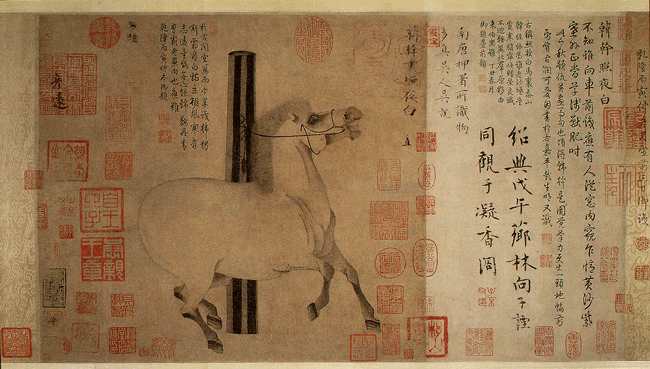Night-Shining White
Tang dynasty (618–906), ca. 750
HAN GAN

– Handscroll; ink on paper; 12 1/8 x 13 3/8 in. (30.8 x 34 cm)
– Purchase, The Dillon Fund Gift, 1977 (1977.78)
HAN GAN
Han Gan, a leading horse painter of the Tang dynasty (618–906), was known for portraying not only the physical likeness of a horse but also its spirit. This painting, the most famous work attributed to the artist, is a portrait of Night-Shining White, a favorite charger of the emperor Xuanzong (r. 712–56). The fiery-tempered steed, with its burning eye, flaring nostrils, and dancing hooves, epitomizes Chinese myths about imported “celestial steeds” that “sweat blood” and were really dragons in disguise. This sensitive, precise drawing, reinforced by delicate ink shading, is an example of baihua (white painting), a term used in Tang texts to describe monochrome painting with ink shading, as opposed to full color painting. The later term baimiao (white drawing) denotes line drawing without shading, as seen in the paintings of Li Gonglin (ca. 1041–1106).
Han Gan is said to have preferred visits to the stables over the study of earlier paintings of horses, and his keen observation of actual animals is confirmed by his accurate rendering of equine movement. But Han’s largely profile image and his reduction of the animal’s anatomy to a series of abstract curves transform Night-Shining White into an archetypal “dragon steed.” Only his addition of pale shading softens the geometry of the drawing, changing flat lines into three-dimensional flesh.
The numerous seals and inscriptions added to the painting and its borders by later owners and experts are a distinctive feature of Chinese collecting and connoisseurship. While collectors are sometimes overzealous in showing their appreciation in this manner, the addition of seals and comments by later viewers served to record a work’s transmission and offers vivid testimony of an artwork’s continuing impact on later generations.
– Photograph Credits
Copyright © 2000–2008 The Metropolitan Museum of Art. All rights reserved.




